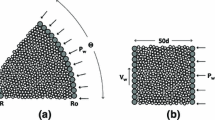Abstract
A model, based on the principles of continuum mechanics, is presented for the analysis of cell-velocity fields within wool follicles. The model requires specification of three follicle characteristics in the form of spatially varying fields: viscosity, cell density and cell production rate. The viscosity is introduced as an attempt to model both complex intercellular interactions and individual cell deformation as the cells move. It is demonstrated that the distribution of cell production is more important than axial variation in viscosity in determining the overall flow pattern.
Similar content being viewed by others
References
Acheson, D. J. (1990). Elementary Fluid Dynamics. Oxford Applied Mathematics and Computing Science Series, Oxford: Oxford University Press.
Batchelor, G. K. (1967). An Introduction to Fluid Dynamics, Cambridge, U.K.: Cambridge University Press.
Black, J. L. (1987). Mechanisms controlling the rate of growth, composition and morphology of wool, in Merino Improvement Programs in Australia B. J. McGuirk (Ed.), Melbourne: Australian Wool Corporation, pp. 457–480.
Black, J. L. and B. N. Nagorcka (1993). Wool growth, in Quantitative Aspects of Ruminant Digestion and Metabolism, J. M. Forbes and J. France (Eds), Cambridge, U.K.: Cambridge University Press, pp. 453–477.
Bird, R. Byron, W. E. Stewart and Lightfoot E. N. (1987). Dynamics of polymeric liquids, in Fluid Mechanics 2nd edn vol. 1, New York: Wiley.
Chapman, R. E., A. M. Downes and P. A. Wilson (1980). Migration and keratinization of cells in wool follicles. Aust. J. Biol. Sci. 33, 587–603.
Chapman, R. E. and K. A. Ward (1979). Histological and biochemical features of the wool fibre and follicle, in Physiological and Environmental Limitations to Wool Growth J. L. Black and P. J. Reis (Eds), Armidale, New South Wales: University of New England Publishing Unit, pp. 193–208.
Fox, L. (1950). The numerical solution of elliptic differential equations when the boundary conditions involve a derivative. Phil. Trans. A242, 345–378.
Gandar, P. W., K. E. Kelly, P. M. Harris and D. W. Dellow (1990). Analysis of growth and cell proliferation in wool follicles, in Modelling Digestion and Metabolism in Farm Animals, A. B. Robson, and D. P. Poppi (Eds), Canterbury, New Zealand: Lincoln University, pp. 189–203.
Holle, S. A. and M. J. Birtles (1990). An immunocytochemical method for studying patterns of cell proliferation in the wool follicle. N.Z. Vet. J. 38, 89–93.
Hynd, P. I. (1989). Factors influencing cellular events in the wool follicle, in The Biology of Wool and Hair, G. E. Rogers, P. J. Reis, K. A. Ward and R. C. Marshall (Eds), New York: Chapman and Hall, pp. 169–184.
Lighthill, M. J. (1975). Mathematical Biofluiddynamics. Philadelphia: Society for Industrial and Applied Mathematics.
Murray, J. D. and G. F. Oster (1984). Cell traction models for generating pattern and form in morphogenesis. J. Math. Bio. 19, 265–279.
Nagorcka, B. N. and J. R. Mooney (1982). The role of a reaction-diffusion system in the formation of hair fibres. J. Theo. Bio. 98, 575–607.
Orwin, D. F. G. and J. L. Woods (1982). Number changes and developmental potential of wool follicle cells in early stages of fibre differentiation. J. Ultrastructural Res. 80, 312–322.
Orwin, D. F. G., J. L. Woods and S. L. Ranford (1984). Cortical cell types and their distribution in wool fibres. Austral. J. Bio. Sci. 37, 237–255.
Oster, G. F., J. D. Murray and P. K Maini (1985). A model for chondrogenic condensations in the developing limb: the role of extracellular matrix and cell tractions. J. Embryol. Exp. Morphol. 89, 93–112.
Reis, P. J., B. N. Nagorcka, D. A. Tunks and S. G. Munro (1990). Variation of length growth rate and diameter of Merino wool fibres, in Proc. 8th International Wool Textile Research Conference, G. H. Crawshaw, (Ed.), Christchurch: Wool Research Organisation of New Zealand, pp. 580–589.
Scott Blair, G. W. (1974). An Introduction to Biorheology, Amsterdam: Elsevier Scientific Publishing Company.
Smith, G. D. (1989). Numerical Solution of Partial Differential Equations, 3rd edn, Oxford: Clarendon Press.
Tanner, R. I. (1988). Engineering Rheology, Oxford: Clarendon Press.
Viswanathan, R. V. (1957). Solution of Poisson’s equation by relaxation methods—normal gradient specified on curved boundaries. Math. Tab., Wash. 11, 67–78.
Wilson, P. A. and B. F. Short (1979). Cell proliferation and cortical cell production in relation to wool growth. Aust. J. Bio. Sci. 32, 317–327.
Zlamál, M. (1967). Discretization and error estimates for elliptic boundary value problems of the fourth order. SIAM J. Numer. Anal. 4, 626–639.
Author information
Authors and Affiliations
Corresponding author
Rights and permissions
About this article
Cite this article
Louie, K., Hall, A.J. & Gandar, P.W. A continuum mechanics approach to determining the cellular velocity field within a wool follicle. Bull. Math. Biol. 60, 79–100 (1998). https://doi.org/10.1006/bulm.1997.0025
Received:
Accepted:
Issue Date:
DOI: https://doi.org/10.1006/bulm.1997.0025




